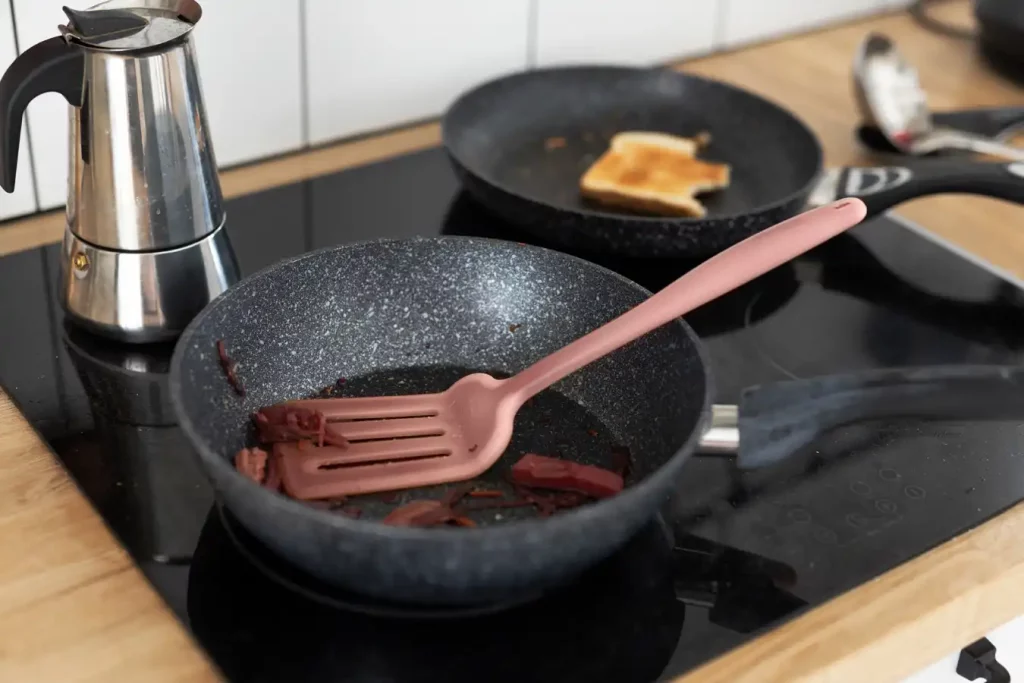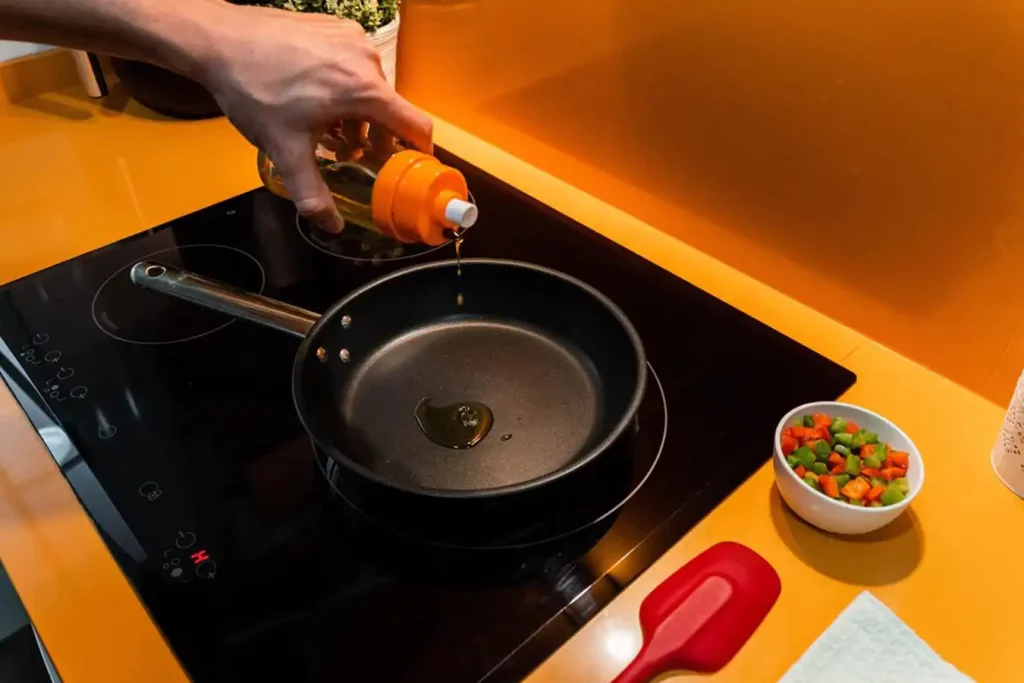Hey there, cooking enthusiasts! Are you pondering on how to protect induction cooktop from cast iron?
This article is your go-to guide, aimed at ensuring your beloved cooktop stays pristine, despite frequent use of your trusty cast iron.
We’re about to unveil a series of efficient, accessible methods, and by the end, you’ll be equipped to protect your cooktop like a pro!
As a passionate blogger and a lover of the great outdoors, and I’m thrilled to help you safeguard your kitchen investments.
So, shall we begin this enlightening expedition together? Your induction cooktop awaits its new line of defense!
Understanding Induction Cooktops and Cast Iron Cookware
To better navigate the safe usage of your cast iron cookware on an induction cooktop, let’s first break down the mechanics of these two kitchen staples.
How Induction Cooktops Work
Imagine this: It’s a chilly winter morning. You put a pot of water on your cooktop, expecting to wait a few minutes for it to boil. But with an induction cooktop, it’s hot and bubbling almost instantly. How does this magic happen?

Unlike traditional stovetops, which use either gas flames or electric heat, induction cooktops use a process called electromagnetic induction. They generate heat directly in the pot or pan, bypassing the need to heat the cooktop itself. This is why induction cooktops are quicker, more energy-efficient, and safer, as they don’t have an open flame or a hot surface.
However, there’s a catch – to work effectively, induction cooktops require cookware made of ferromagnetic materials. Cast iron fits the bill perfectly, but can it be safely used? Let’s dig deeper.
Why Use Cast Iron on Induction Cooktops?
Cast iron pans are a treasured possession in many kitchens – they’re durable, versatile, and have exceptional heat-retaining properties. The dense, heavy nature of cast iron makes it perfect for slow-cooking and browning, while also being induction-ready due to its ferromagnetic properties. But, these same qualities make cast iron capable of scratching the smooth, glossy surface of your induction cooktop if not used with care.
The Risks of Using Cast Iron Cookware on Induction Cooktops
One might argue that the marriage between induction cooktops and cast iron pans is a match made in heaven. However, like any relationship, it comes with its unique set of challenges. The dense and rugged texture of cast iron cookware, though excellent for heat retention, can potentially scratch or crack the sleek and delicate surface of your induction cooktop if not handled with care.
Furthermore, rapid heating and drastic temperature changes could lead to ‘thermal shock,’ causing your cooktop to crack. Moreover, using cookware larger than the heating ring could lead to uneven heating and energy waste. Awareness of these risks is the first step towards safeguarding your cooktop.
Steps to Protect Your Induction Cooktop When Using Cast Iron
By now, you’re well-versed in the pros and cons of pairing your cast iron cookware with an induction cooktop. Let’s now navigate the steps you can take to ensure a damage-free cooking experience.
Step 1: Cleaning Your Cooktop and Cookware
Keeping both your cooktop and cast iron pan clean is crucial. Dirt and grit trapped between the cooktop and cookware could lead to scratches. So, before you start cooking, wipe down your cooktop with a soft, damp cloth. As for your cast iron pan, clean it after each use. Avoid using harsh cleaning agents, instead opting for a mixture of coarse salt and oil to scrub off any stubborn residues.
Step 2: Using the Right Size of Cookware
Size does matter when it comes to induction cooking! Always ensure that the size of your cast iron cookware aligns with the size of the burner. Oversized pans could lead to inefficient cooking and potential damage to the cooktop surface.
Step 3: Gradual Heating
Though induction cooktops are praised for their rapid heating capability, when using cast iron, it’s best to play it slow. Gradually increase the heat to avoid a sudden temperature spike which could harm both your cooktop and your cookware.
Step 4: Avoid Sliding Your Cookware
Cast iron cookware, with its rough texture, can easily scratch the glass surface of an induction cooktop if slid around. So, it’s best to lift and place your pan instead of sliding it across the surface. Remember, it’s all about gentle handling!
Step 5: Using Protective Layers
A simple, yet effective way to protect your cooktop is by using a protective layer between it and the pan. Silicone baking mats or parchment paper can serve as a barrier, shielding the cooktop from potential scratches. However, it’s crucial to monitor your cooking closely to prevent these materials from overheating or burning.
While this might seem like a lot of caution, once you get the hang of it, these steps will become second nature.
Learn more also: Remove Carbon Buildup on Cast Iron Skillets
Additional Tips for Long-Lasting Induction Cooktops and Cast Iron Cookware
Beyond the crucial steps outlined, a few more tips can contribute to the longevity and effectiveness of both your induction cooktop and cast iron cookware. For example, seasoning your cast iron pan regularly not only enhances its non-stick properties but also prevents rust and keeps it in good condition for longer.
Additionally, always allow your induction cooktop to cool down after use before cleaning it. This prevents the risk of thermal shock. And don’t forget to use cookware with a flat base, which guarantees better contact with the cooktop for efficient heat transfer.
Remember, regular and mindful maintenance goes a long way in preserving the life and performance of your kitchen appliances.
FAQs about Protect Induction Cooktop from Cast Iron
Will a cast iron skillet scratch an induction cooktop?
What is the best way to protect an induction cooktop?
Can you use enameled cast iron on induction cooktop?
Is parchment paper safe for induction cooktop?
Can you use cast iron on induction?
Conclusion
So there you have it, a comprehensive guide on how to safely use your cast iron cookware on an induction cooktop. From understanding the basic mechanics of induction cooking and cast iron pans, to acknowledging the potential risks and learning the protective measures, we’ve covered it all.
At the end of the day, the primary takeaway is to use and handle both with care. Your induction cooktop and cast iron pan can serve you for years, providing many delightful meals, if treated right. The key lies in the balance of enjoying the benefits while being mindful of their unique needs. Happy, and safe, cooking to you all!


